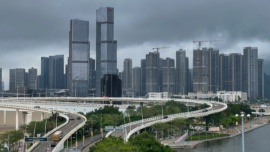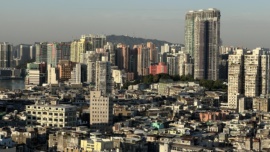Macau Business | December 2021
By Zhang Ruopiao
On October 13, 2021, the 15th meeting of the Conference of the Parties to the UN Convention on Biological Diversity (COP15) in Kunming, Yunnan Province, adopted a declaration on the need for concerted effort and momentum to halt and reverse the loss of biodiversity. The Kunming Declaration embodies the political determination of the Chinese government to address the challenges of biodiversity and jointly build a community of life on Earth. The Declaration commits to ensuring the formulation, adoption, and implementation of an effective post-2020 global biodiversity framework.

Executive Council Member
Macau Institute for Corporate Social Responsibility in Greater China (MICSRGC)
The framework aims to reverse current biodiversity loss and place it on a path to recovery by 2030, at the latest, to achieve the 2050 vision of living in harmony with nature. Along with the Kunming Declaration, China’s first white paper (an in-depth report), Biodiversity Conservation in China, was published in October this year, pledging a new chapter for ecological conservation in China.
The term “biodiversity” refers to the entire variability of life on Earth, as well as the settings in which it thrives. Biodiversity’s ecological goods and services offer the foundations for human civilization and long-term development (WWF (2018). Living Planet Report 2018). However, the world is facing a critical situation of unprecedented species extinction. Biodiversity loss and ecosystem degradation pose a major threat to human survival and sustainable development. In 1972, the United Nations convened the Conference on the Human Environment. The participating countries signed the Declaration on the Human Environment, in which the conservation of biological resources was included in the 26 principles. In 1993, the Convention on Biological Diversity (CBD) came into force.
China is a vast country with complex and diverse landscapes and climates, making it one of the richest countries in the world in terms of biodiversity. However, rapid urbanization and industrialization have posed new dangers to species and ecosystems, as well as increased demand on their habitats. The detrimental effects on biodiversity have been exacerbated by overexploitation and the uncontrolled growth of biological resources. Pollution has had a significant influence on aquatic and riverine biodiversity and ecosystems. Thus, China’s rapid economic expansion is unsustainable since it has exceeded its environmental capacity and ecological biocapacity for the past few decades. To mitigate the biodiversity loss, China has made significant strides in building a system of environmental reserves and safeguarding endangered species since 2017. The Ministry of Natural Resources and provincial ecological redlines were established. In addition, nature reserve oversight was tightened to unprecedented levels, and considerable successful biodiversity conservation experience was gained.
On February 18, 2019, the Central Committee of the Communist Party of China and the State Council issued the Outline of the Development Plan for the Greater Bay Area of Guangdong, Hong Kong, and Macao. The plan proposed to apply a strict ecological protection system while innovating a green and low-carbon development model. During the past few decades, the urban development of the Guangdong-Hong Kong-Macao Greater Bay Area imposed ecological damage. For example, during the industrialization and urbanization in Guangzhou’s Panyu and Nansha districts, most of the wetland landscapes were replaced by infrastructure, such as bridges, roads, and ports. This change resulted in serious damage to the biodiversity of insects there.
According to the Guangdong, Hong Kong and Macao Greater Bay Area Ecological Footprint Report 2019, the Greater Bay Area has only 0.27 global hectares of biological carrying capacity per capita which is one-fourth of the national average and one-sixth of the worldwide average. The Kunming Declaration further rings alarm bells for biodiversity conservation in this area. The Guangdong Marine Ecological Red Line Report shows that the resource constraints on the coastline of the Greater Bay Area are tightening. Additionally, the rate of loss of coastal wetlands in this area is high, and the quality of marine organisms is on the decline.

The natural systems and biochemical cycles that come with biodiversity are prerequisites for the prosperity of the Greater Bay Area. In the next 10 to 20 years, the population of the area is expected to increase significantly, imposing greater challenges upon the ecological system. After a series of biodiversity-related summits, the Greater Bay Area is launching various programs to promote regional biodiversity. Specifically, the National Development and Reform Commission and the Ministry of Natural Resources jointly issued the Key Projects for Biodiversity Conservation in the Guangdong-Hong Kong-Macao Greater Bay Areaand the Three-Year Action Plan to Promote Ecological Protection, Restoration and Mitigation in the Coastal Zone of Guangdong-Hong Kong-Macao Greater Bay Area (2020-2022).These action plans further strengthen the cooperation between Guangdong, Hong Kong, and Macao in data sharing, scientific research, and innovation to enhance ecological corridors and biodiversity protection networks.
However, this article argues that most of the ecosystem services “provided” by nature are public goods, which fall under the category of “externalities” in the economic sense. Therefore, we cannot expect market forces alone to solve the problem of biodiversity loss. Government policy interventions are essential.
The global ravages of the COVID-19 epidemic are a warning sign that we should be aware of the close connection between humans and nature and the catastrophic consequences of breaking this bond. At the same time, we must also be aware that we have ignored the even greater risks to humanity posed by global climate change and the sharp decline in biodiversity to date. Biodiversity is related to human well-being and is an essential basis for human survival and development. The COP-15 is calling to incorporate biodiversity conservation into long-term socio-economic and industrial development planning. The COP-15 and Kunming Declaration shed light on how the international community should work together to address these major risks in terms of biodiversity. The Greater Bay Area is facing complex biodiversity conservation challenges and opportunities, and more than ever, putting biodiversity at the heart of sustainable development is critical to the future of ecological and community life and the systems that support them.
























